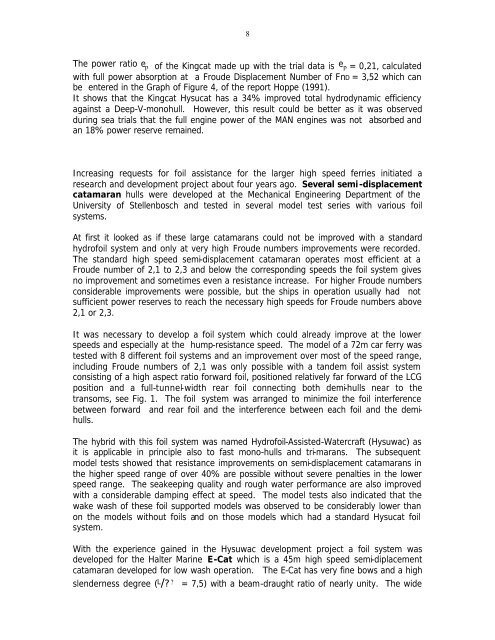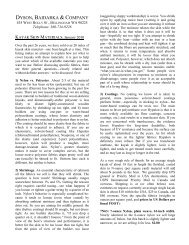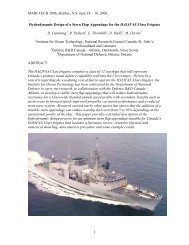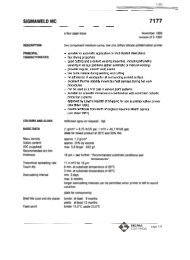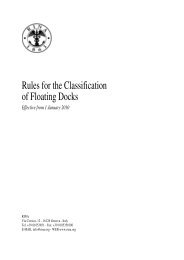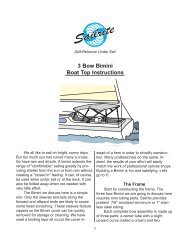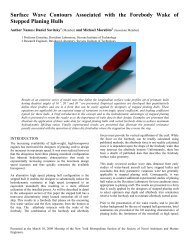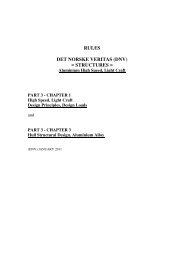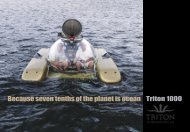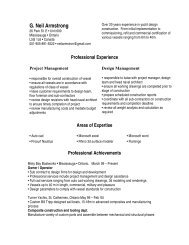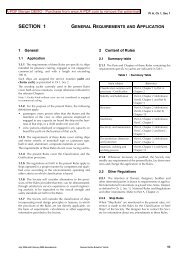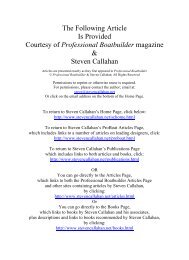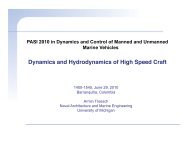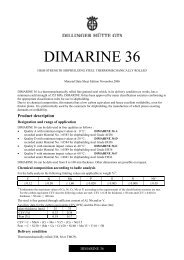Recent Applications of Hydrofoil-Supported- Catamarans - Boat ...
Recent Applications of Hydrofoil-Supported- Catamarans - Boat ...
Recent Applications of Hydrofoil-Supported- Catamarans - Boat ...
You also want an ePaper? Increase the reach of your titles
YUMPU automatically turns print PDFs into web optimized ePapers that Google loves.
8The power ratio e p <strong>of</strong> the Kingcat made up with the trial data is e p = 0,21, calculatedwith full power absorption at a Froude Displacement Number <strong>of</strong> FnD = 3,52 which canbe entered in the Graph <strong>of</strong> Figure 4, <strong>of</strong> the report Hoppe (1991).It shows that the Kingcat Hysucat has a 34% improved total hydrodynamic efficiencyagainst a Deep-V-monohull. However, this result could be better as it was observedduring sea trials that the full engine power <strong>of</strong> the MAN engines was not absorbed andan 18% power reserve remained.Increasing requests for foil assistance for the larger high speed ferries initiated aresearch and development project about four years ago. Several semi-displacementcatamaran hulls were developed at the Mechanical Engineering Department <strong>of</strong> theUniversity <strong>of</strong> Stellenbosch and tested in several model test series with various foilsystems.At first it looked as if these large catamarans could not be improved with a standardhydr<strong>of</strong>oil system and only at very high Froude numbers improvements were recorded.The standard high speed semi-displacement catamaran operates most efficient at aFroude number <strong>of</strong> 2,1 to 2,3 and below the corresponding speeds the foil system givesno improvement and sometimes even a resistance increase. For higher Froude numbersconsiderable improvements were possible, but the ships in operation usually had notsufficient power reserves to reach the necessary high speeds for Froude numbers above2,1 or 2,3.It was necessary to develop a foil system which could already improve at the lowerspeeds and especially at the hump-resistance speed. The model <strong>of</strong> a 72m car ferry wastested with 8 different foil systems and an improvement over most <strong>of</strong> the speed range,including Froude numbers <strong>of</strong> 2,1 was only possible with a tandem foil assist systemconsisting <strong>of</strong> a high aspect ratio forward foil, positioned relatively far forward <strong>of</strong> the LCGposition and a full-tunnel-width rear foil connecting both demi-hulls near to thetransoms, see Fig. 1. The foil system was arranged to minimize the foil interferencebetween forward and rear foil and the interference between each foil and the demihulls.The hybrid with this foil system was named Hydr<strong>of</strong>oil-Assisted-Watercraft (Hysuwac) asit is applicable in principle also to fast mono-hulls and tri-marans. The subsequentmodel tests showed that resistance improvements on semi-displacement catamarans inthe higher speed range <strong>of</strong> over 40% are possible without severe penalties in the lowerspeed range. The seakeeping quality and rough water performance are also improvedwith a considerable damping effect at speed. The model tests also indicated that thewake wash <strong>of</strong> these foil supported models was observed to be considerably lower thanon the models without foils and on those models which had a standard Hysucat foilsystem.With the experience gained in the Hysuwac development project a foil system wasdeveloped for the Halter Marine E-Cat which is a 45m high speed semi-diplacementcatamaran developed for low wash operation. The E-Cat has very fine bows and a highslenderness degree ( L /? ? = 7,5) with a beam-draught ratio <strong>of</strong> nearly unity. The wide


